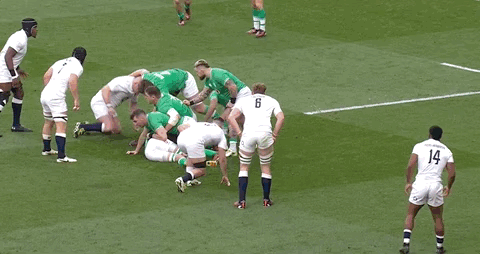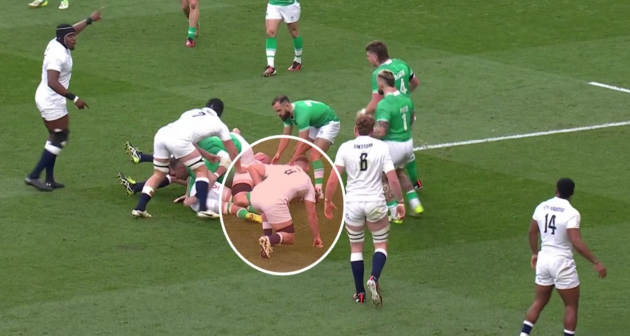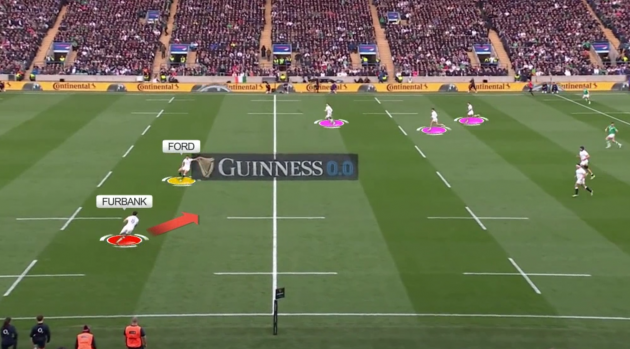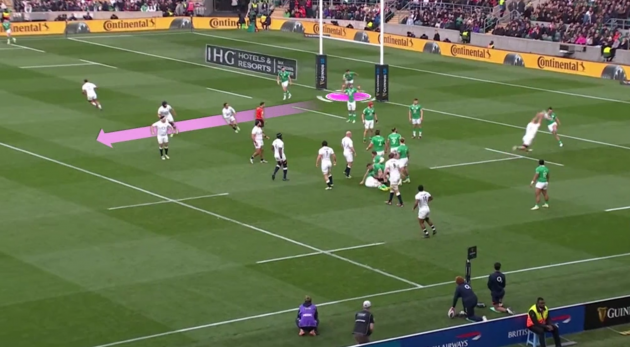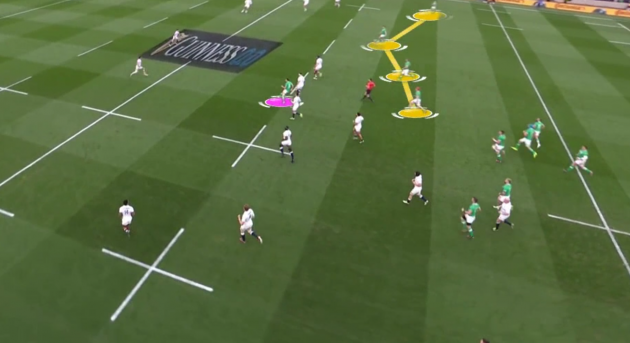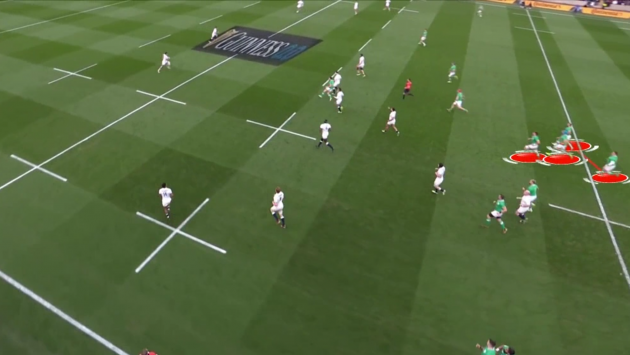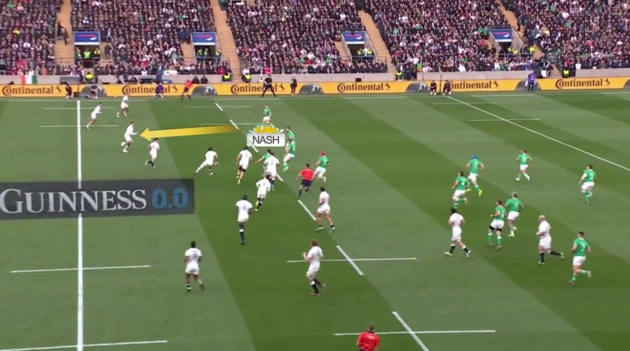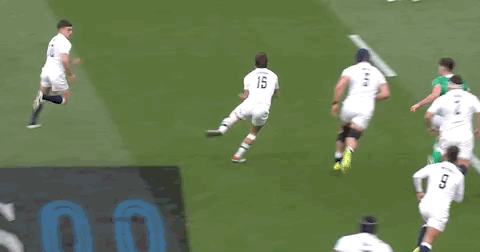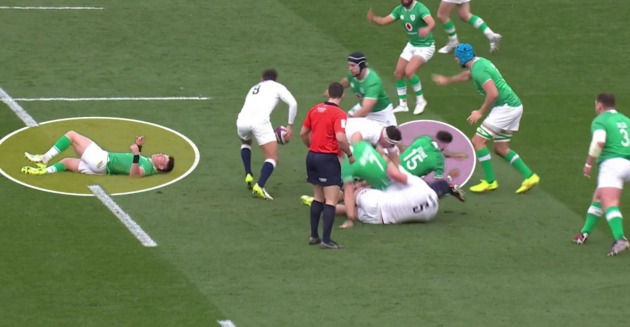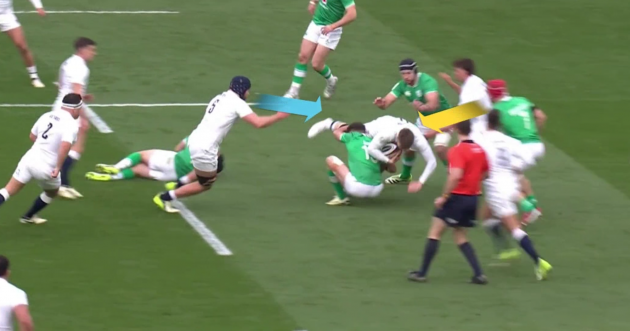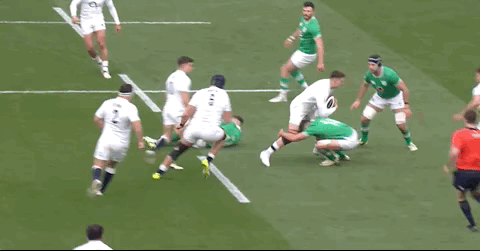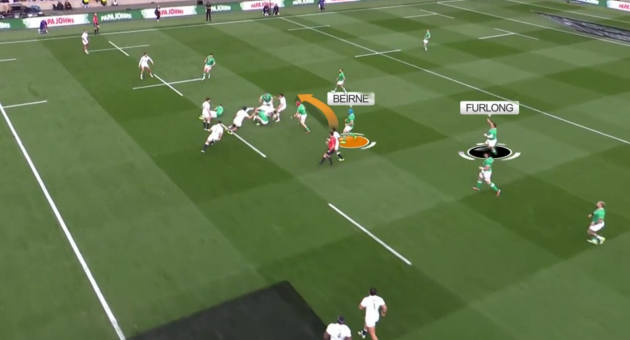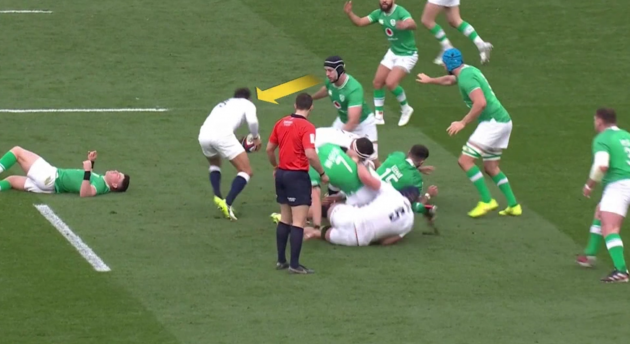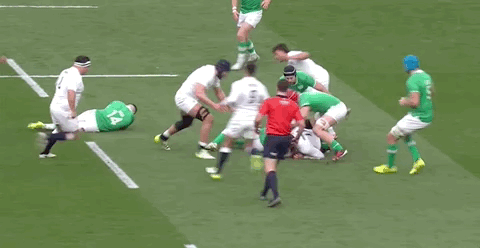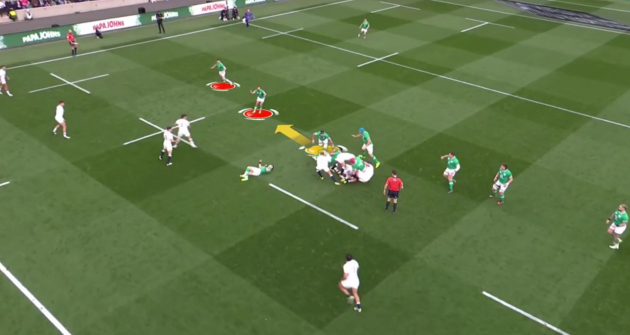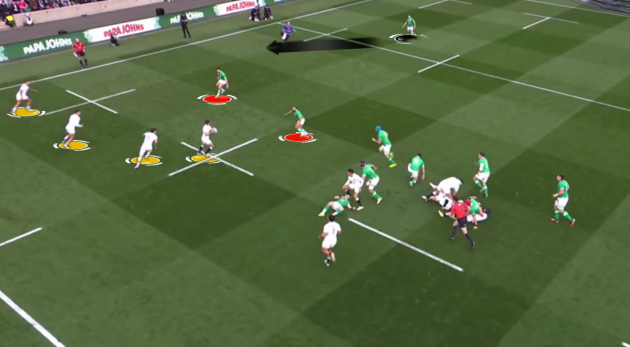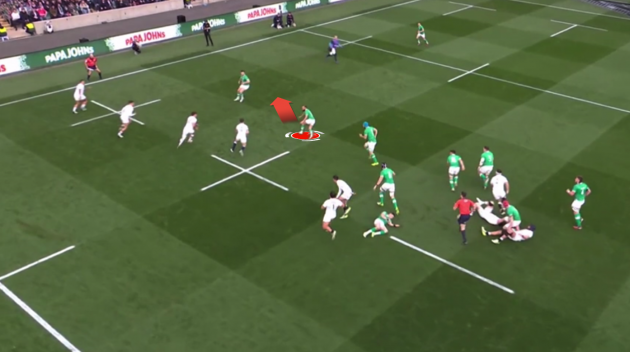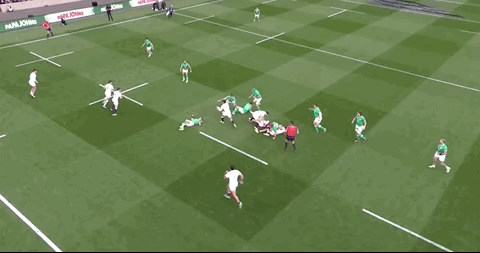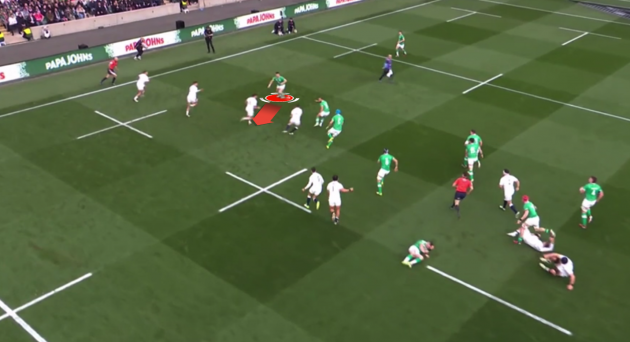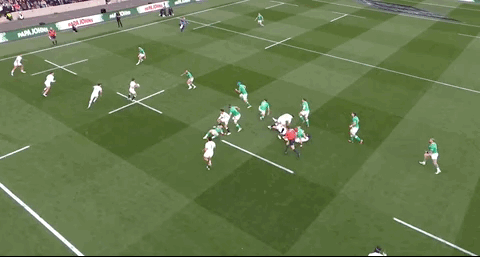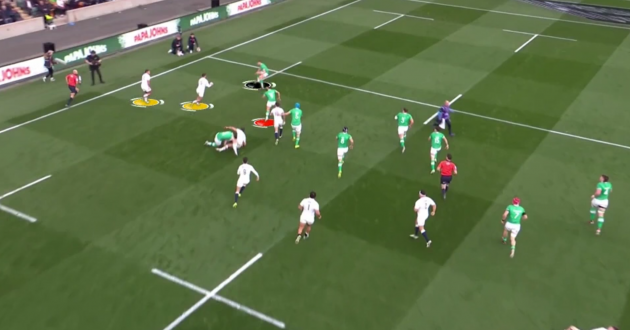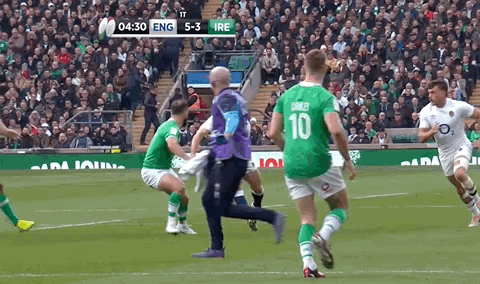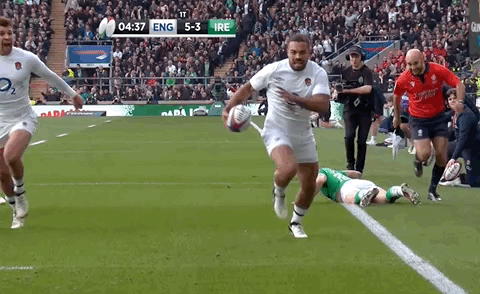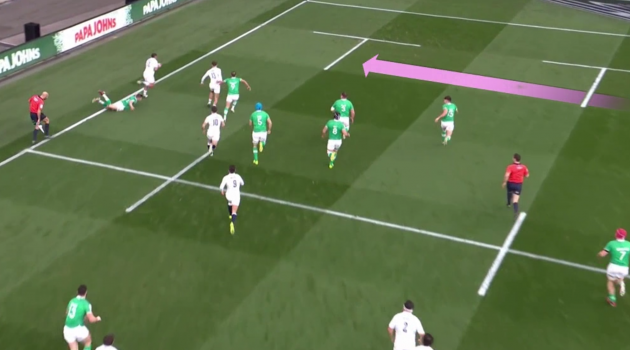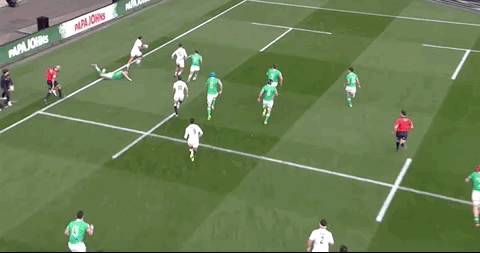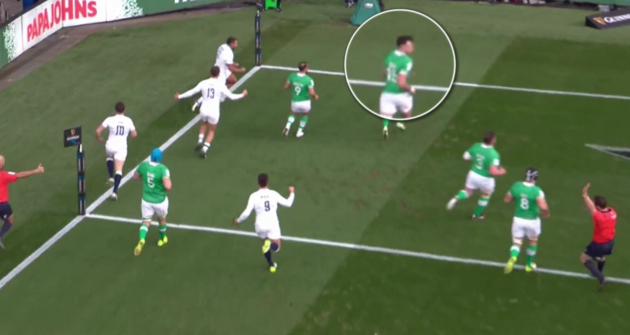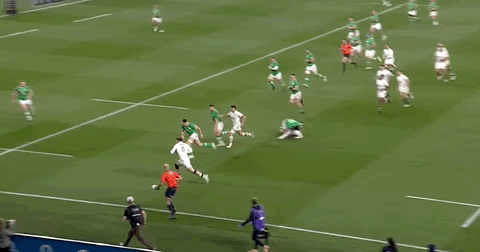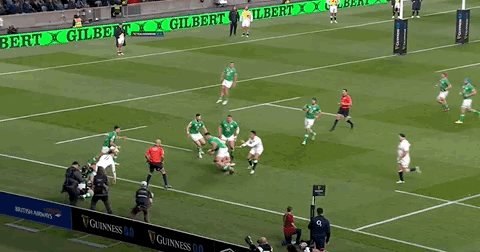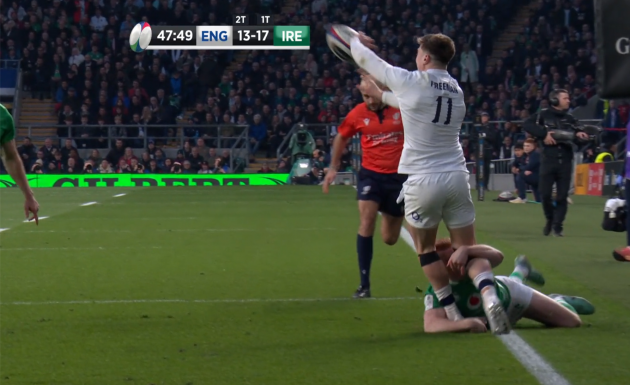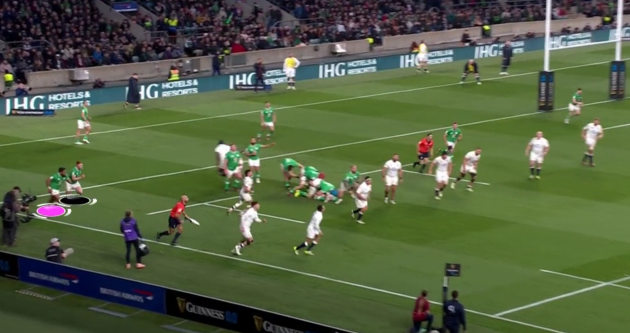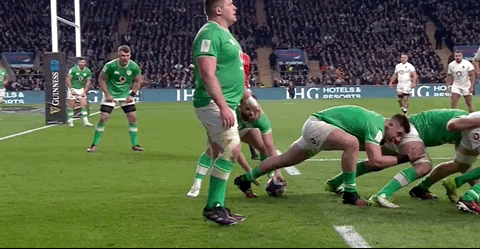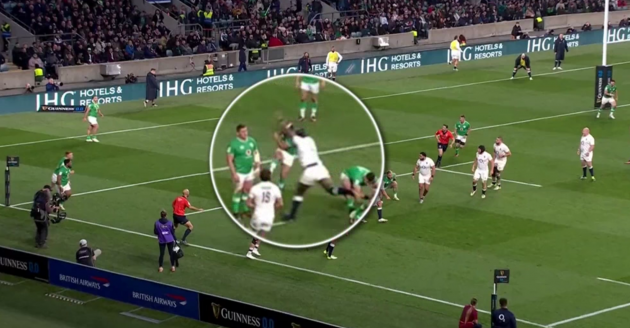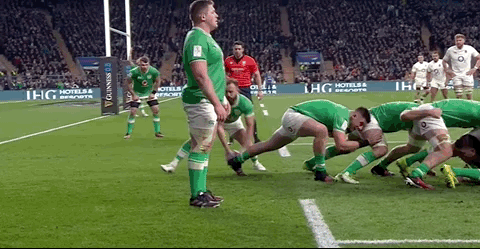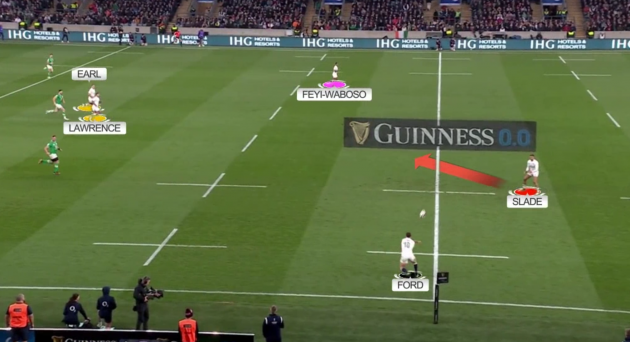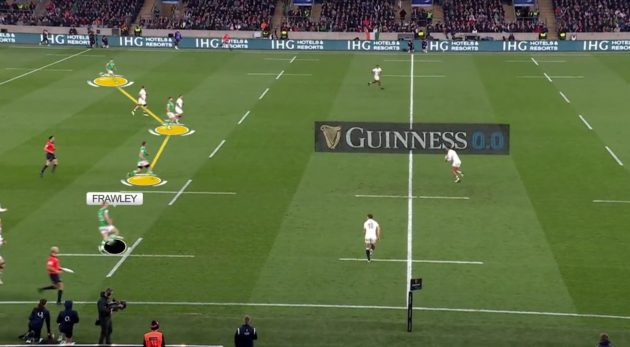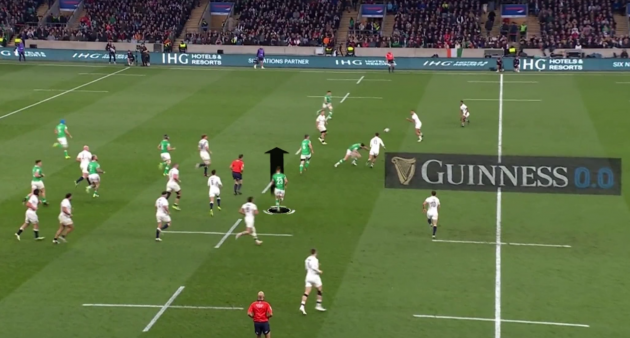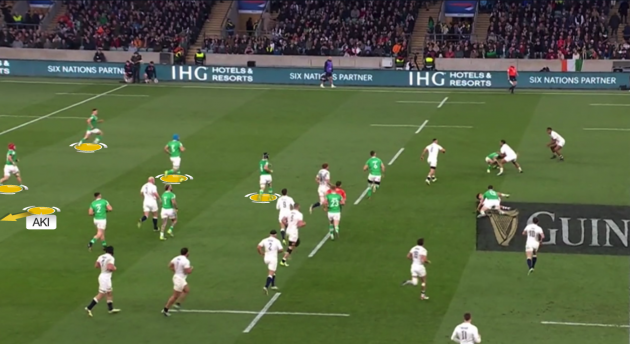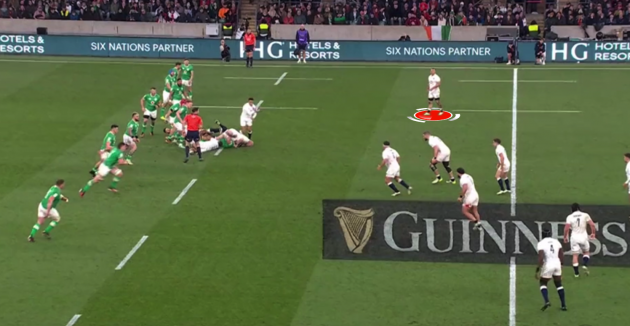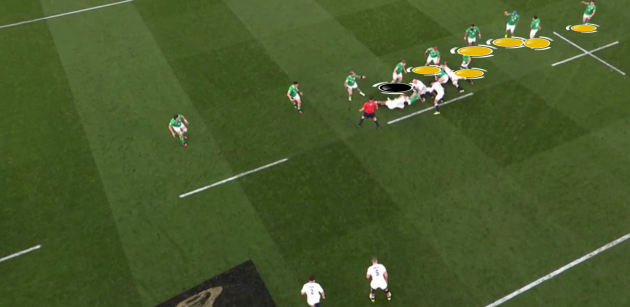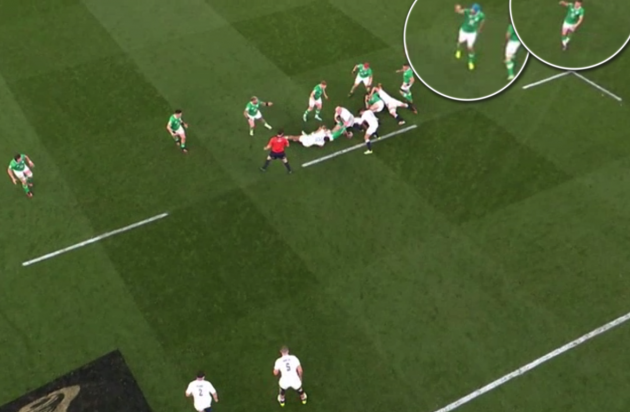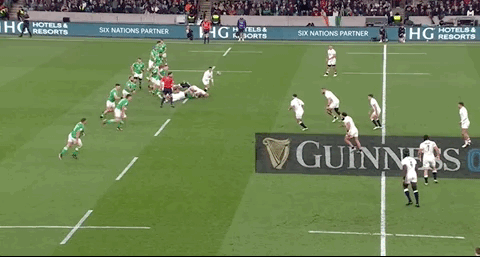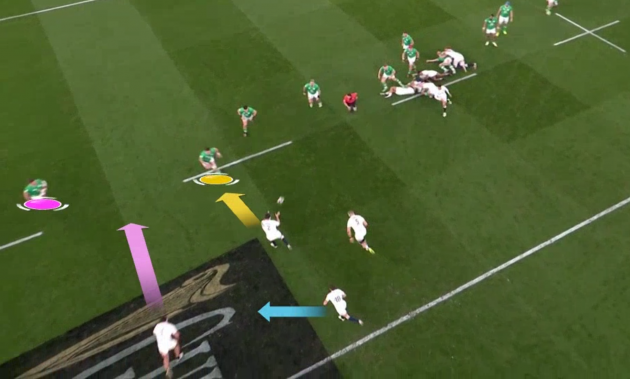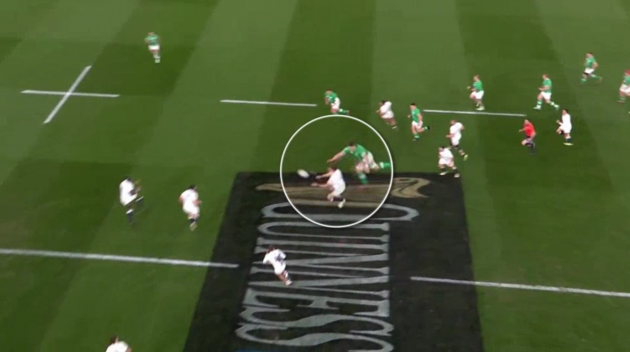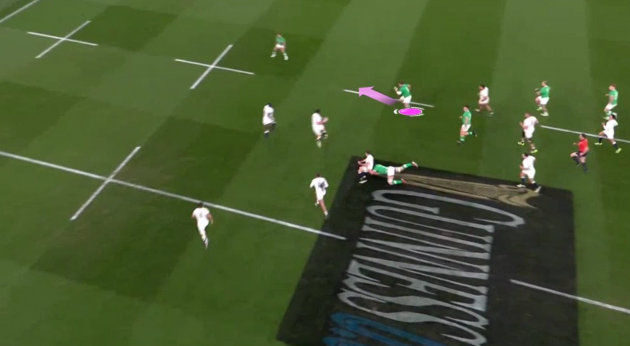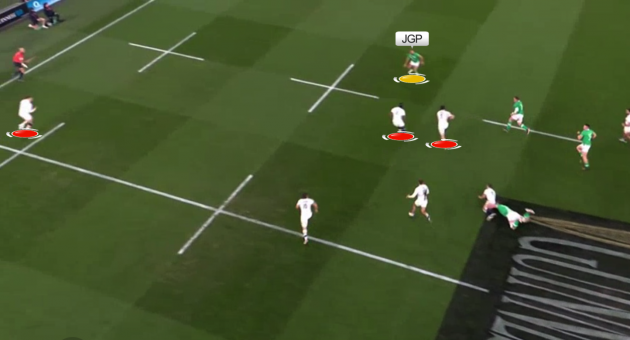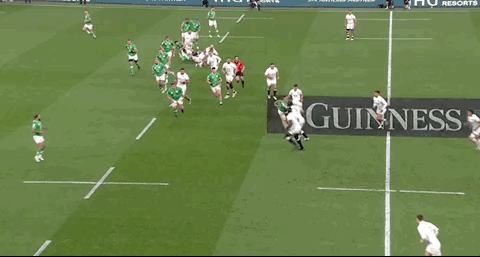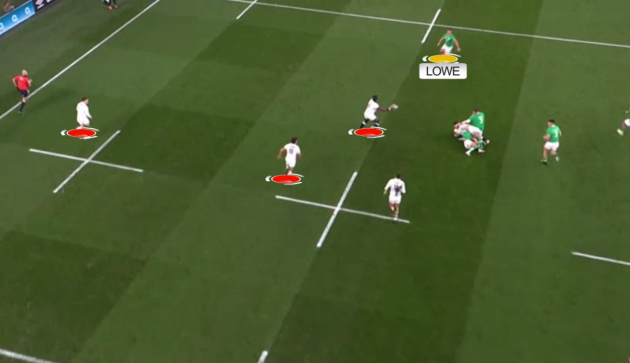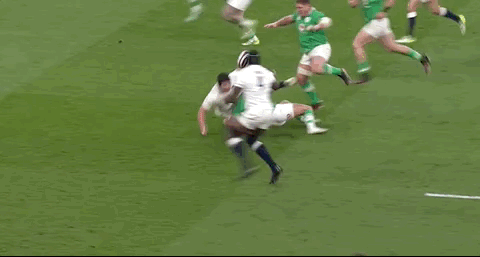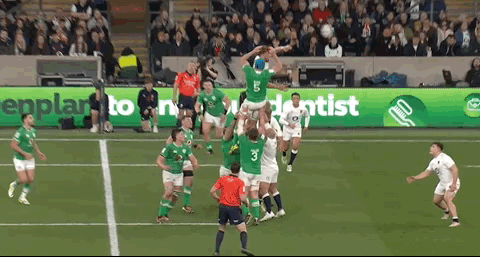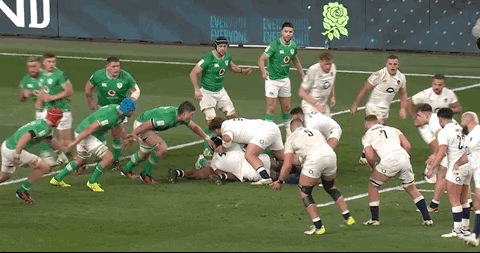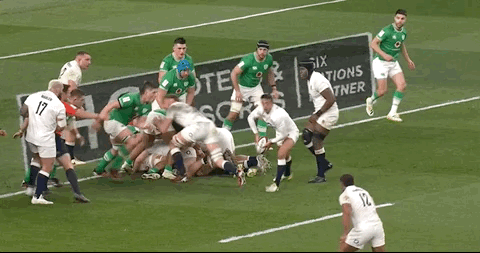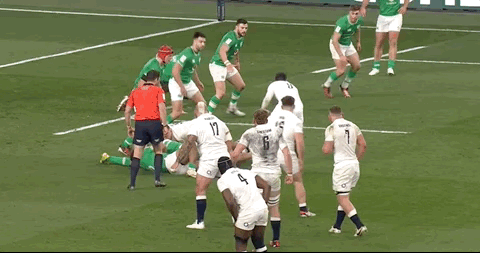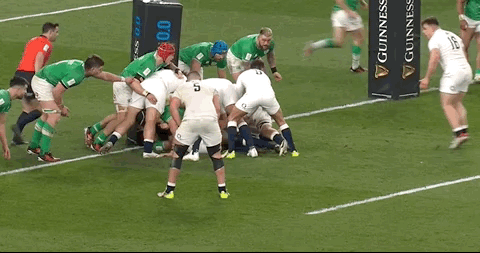IRELAND DON’T OFTEN concede more than two tries in a single game.
It has only happened twice in the last 20 months – against England last Saturday and against New Zealand in last year’s World Cup quarter-final when both opponents scored three tries. Those also happen to be the only games Ireland have lost in that timeframe.
The quality of the Irish defence has been pivotal to their success, with Simon Easterby leading this area, but it took backward steps in Twickenham. That should mean an ultra-focused defensive performance this Saturday against Scotland, who have plenty of attacking talent.
After conceding a total of just seven linebreaks in their opening three Six Nations wins, Ireland conceded eight linebreaks in their 23-22 defeat to the English.
Steve Borthwick’s side also bossed the gainline, getting over it with a whopping 59% of their carries, according to Opta. By way of comparison, France got over the gainline with 48% of their carries against Ireland, Wales managed 37%, and Italy just 24%.
Conceding an early try is always a major psychological setback for any team, usually meaning they are quickly into the position of chasing, and Ireland were hit as early as the fourth minute on Saturday.
The try comes after Ireland have made a solid start to take a 3-0 lead. England restart long to Ireland’s left, from where they know James Lowe’s big left boot comes into play.
England were keen to take on that strength directly rather than avoiding it. They wanted to put Lowe’s long kicking under pressure, as they do here.
The pressure comes from England back row Ben Earl, who gets into a three-point sprinter’s stance very early, readying himself to explode out of the blocks and target Lowe’s left foot.
Watch below how Ireland scrum-half Jamison Gibson-Park looks at Earl, then feints to pass before he actually does. Scrum-halves aren’t supposed to do this but it’s subtle.
That feint with the shoulders and/or head can often unbalance defenders readying themselves to burst forward but Earl and England have done their homework – they know Gibson-Park is likely to do this.
Earl doesn’t buy the feint, instead calmly resetting himself and then racing forward when Gibson-Park passes. As Lowe looks to kick, he’s aware of Earl thundering up at him looking for the block and it results in a relatively scruffy connection with the ball. Earl also flies up to Lowe’s left, dissuading him from kicking straight to touch.
The body language of the Irish players around Lowe suggests that their plan was to find touch but that’s not the case as Earl’s presence helps to ensure the kind lands infield.
There is still good length on Lowe’s kick, which skids up into the English half but it’s on a low trajectory and doesn’t hang in the air for long, so Ireland don’t have optimal to get a convincing chase on as England show immediate intent on kick return.
Fullback George Furbank collects the bouncing ball a few metres inside his own half and instantly accelerates infield, with out-half George Ford encouraging him to do so, strongly suggesting that England have a specific plan for this first kick return.
On the far side of the pitch, centres Ollie Lawrence and Henry Slade and left wing Tommy Freeman [all in pink] are working very hard to get back downfield to be part of the counter.
The only Irish player behind Lowe as he kicks is fullback Hugo Keenan so his job is to sprint upfield and bring everyone else onside, allowing them to join the chase.
Given that Lowe is kicking, Ireland don’t have a left wing to chase up that touchline. Ireland sometimes relocate Keenan to that position to chase kicks on that side but that’s not the case here.
Keenan [pink below] hares upfield and gets to Ireland’s 10-metre line, ensuring that Furbank himself can’t just sprint straight down the middle of the pitch for big gains.
As we can see above, Josh van der Flier, Caelan Doris, and Robbie Henshaw [yellow] are connecting in behind lead chaser Keenan, while right wing Calvin Nash has also come forward on that side of the pitch.
However, the rest of the Irish players on their left have been a hint slow to get moving upfield, again suggesting that they expected the ball to go into touch.
This group in red above are the players who will get closest to the tackle over on Ireland’s right and as we’ll see, they’re unable to get one defender across to the other side of the breakdown, which proves costly.
While Ireland aren’t in catastrophic condition, it already looks likely they’re going to be stretched and that England will make it over Ireland’s 10-metre line at least, ensuring an unsuccessful Irish exit.
England’s backs working hard to reload out on their left means they have attacking numbers there and Furbank decides to move the ball to Freeman, sparking Nash into an aggressive decision.
Nash reads Furbank’s pass to Freeman and decides to shoot up to try and make a ball-and-all tackle that kills the attack.
It’s the right decision from Nash. If he is successful here, he lands a massive tackle on Freeman and prevents the ball from being moved wider. He also hopes to give his team-mates a chance to target the ball on the ground or at least get well set for the next phase.
But Nash comes off second-best. He is left crumpled on the pitch in obvious discomfort.
It’s excellent strength from Freeman to ride the collision and get moving forward straight away. With Nash immediately falling to the ground, it’s Keenan who has to make the tackle low on Freeman coming from the inside.
That means that not only is Nash [yellow below] out of the game with his head injury, and therefore unable to work back into the defensive line for the next phase, but Keenan [pink] is also out of the game on the ground.
There’s a strong element of misfortune here for Ireland with Nash getting injured. Not only does it mean he can’t complete that first tackle to halt the English momentum, but it also leaves Ireland short of one defender – either Nash or Keenan – for the next phase.
Still, Ireland will feel they could have managed the situation better and clung on.
As Keenan tackles Freeman, van der Flier identifies the possibility of a turnover at the breakdown [yellow below]. As we can see, there is an opening for van der Flier, with Furbank ahead of the tackle and unable to clearout. Van der Flier gets into a strong position.
But England lock George Martin [blue above] understands the threat and he delivers a brilliant clearout to deny van der Flier the chance to even slow the ball down.
Watch below as Martin dips in low and hammers into van der Flier, bouncing him off balance and upwards, then dragging him away to the side.
Martin’s intervention means England get a lightning-quick recycle of around one second at this breakdown, giving Ireland no time to get organised in defence.
Even before the ball has been recycled, it’s clear that there is major danger for Ireland down the shortside.
Keenan is tackling Freeman in the shot below and we can see that Ireland prop Tadhg Furlong is shouting for his team-mates to ‘fold’ over to the shortside, which is so exposed. Ireland desperately need another defender over there.
Furlong seemingly wants Beirne to fold over to that side but Beirne initially appears to be concerned by the possibility of England scrum-half Alex Mitchell sniping to Ireland’s left side of the breakdown and briefly pauses in that spot.
Had Beirne folded earlier, Ireland obviously would have had extra cover in the shortside and therefore a better chance to deal with the next phase but England’s speedy recycle means he only begins to move across when it’s too late.
Accentuating the problem in the shortside is the fact that Doris looks to pressure Mitchell close to the breakdown.
We can see that Beirne is now signalling for Doris to push wider as he folds around the corner, while Gibson-Park outside is also beckoning – possibly for Doris to ease off and instead drift away from Mitchell to try and help manage the English overlap.
Doris is seemingly hoping to snaffle Mitchell with the ball or dislodge it from his grasp, but as we see below the English scrum-half is able to slip his pass away and Doris is out of the game.
Now we have to remember how quickly all of this is happening – cutting decision-making time to the bare minimum – but the alternative for Doris [yellow below] is to be more passive, standing off Mitchell and trying to shepherd him before the pass, then drifting cross-field to allow Gibson-Park and Henshaw [red] to also shift one attacker wider.
Ireland are normally intent on being aggressive defensively and coming forward but this is a unique scenario where there is a danger of being cut apart, so sometimes teams adjust in those circumstances.
We can see how exposed Gibson-Park and Henshaw are in the shortside.
The opportunity for England is magnified by Furbank’s fine work off the ball [red below], sprinting back from that position just in front of the tackle on Freeman to reload and be part of the attacking line.
So as Mitchell’s pass finds out-half Ford, there is a 4-on-2 chance for England in the frontline.
As highlighted in black above, Ireland out-half Jack Crowley is in the backfield and will close up to the edge but that still makes it a 4-on-3 chance for England to score.
With Beirne now folding across, Gibson-Park [red below] is hopeful that he can buy time and sit off Ford, allowing Beirne to get across and deal with the English out-half.
Watch below how Gibson-Park retreats downfield, with Henshaw outside him initially mimicking that movement.
But also watch how Ford ‘squares up,’ straightening the line by darting straight upfield at Gibson-Park to sit him down and not allow the Ireland scrum-half to drift off early.
Even as Ford passes, Gibson-Park is doing his utmost to stay alive as a defender, backing away and chopping his feet in the hope he can still shift out onto the next attacker after the pass.
But Henshaw [red below] has already made a decision to bite down on Furbank, again with the hope of stopping the ball in the tackle.
The other option for Henshaw is to stay in drift mode and hope Gibson-Park can get to Furbank but again, these players are conditioned to be aggressive and Henshaw tries to shut the attack down. There’s also the worry that Gibson-Park won’t be able to drift out onto Furbank, who is quick and could break himself if Henshaw doesn’t stay on him.
A brilliant bit of skill from Furbank sees him narrowly get the ball away to Slade outside with a slick catch-pass under pressure from Henshaw.
And so, the excellent work from Ford and Furbank in running straight means England have preserved what is essentially a 2-on-1 out on the edge as Crowley [black below] closes up.
Crowley can see that Gibson-Park [red above] is still working hard to track back but it’s very difficult for Crowley to shift off Slade too early and give the English centre a chance to sprint for the line.
Crowley pauses briefly on Slade to prevent that from happening and Slade continues the English theme of doing an excellent job of running straight to engage the defender before passing to Lawrence outside.
Crowley now shifts out towards Lawrence but he’s in a tough spot stretching to catch up after briefly planting his feet while Slade has engaged him.
Lawrence is a powerful player and he uses his fend expertly here, switching the ball into his outside arm to carry so he can use his right hand to fend Crowley.
We can see that Crowley isn’t able to get his body out in front of Lawrence or plant his right leg close to the England centre to give him power and stability into the tackle.
Crowley knows the fend is coming and tries to bat it down but Lawrence is strong and balanced with his carry to burst past the despairing tackle attempt.
The English centre strides clear and even has time to come up with a spectacular finish.
It’s notable that Lawrence is under so little pressure as he finishes in the corner here. Most of the time, there would be another defender sweeping across the backfield and ‘corner-flagging’ in a last-gasp attempt to stop the score.
But as we can see again below, that’s not the case.
Having sprinted back from his tackle on Freeman in vain, Ireland fullback Keenan watches Lawrence finish and then looks over to his right, possibly wondering why there was no one corner-flagging.
Lowe seems to have been the defender tasked with starting on the left side of Ireland’s backfield as Crowley covered the right, so Lowe would be the obvious one to track across as England attacked to Ireland’s right and Crowley was called on to close up from the backfield.
But Lowe doesn’t appear to track across in this case. Perhaps Ireland have changed their defensive system or perhaps it was the unique circumstances of Nash getting injured that affected how they defended the backfield.
Even had Lowe worked across, the sheer speed of England’s attack would have made it difficult for him to get to the far touchline quickly enough to get close to Lawrence.
Still, it’s one of several aspects of this score that Ireland will probably have discussed as England struck brilliantly to take a lead that seemed to set the tone for this game. It was a superb plan from England that they executed wonderfully.
And Ireland got stung in a similar fashion for England’s second try in the second half as another exit kick sparked Borthwick’s side into life.
Again, the try involved an Irish player suffering a head injury. Just before Ireland kick, Ciarán Frawley – who was Nash’s replacement – makes a tackle close to the touchline after England have got outside them with a precise lineout attack.
Frawley makes a good tackle on Freeman but takes a blow to the head in the process and we can see him wobbling badly as he gets back to his feet below.
Frawley reaches for his head as he walks back but play has continued, even though Freeman has a foot in touch before offloading. The fact that Frawley has taken that blow to the head proves to be influential.
It should be an Irish lineout but play continues as Ireland hooker Dan Sheehan gathers the loose ball and they go into their routine for an exit kick, which they would have done from a lineout anyway – although in a more organised fashion and probably without a discombobulated player.
As we can see, Frawley [pink below] has stayed near the right touchline to chase the kick up that side of the pitch. But centre Bundee Aki [black below] is also in the same role close to the right touchline, which is unusual.
Just before the kick, we can see that Robbie Henshaw in midfield is screaming for one of those Irish backs to get infield to bulk up the chase line in that area.
So already we’re seeing an element of apparent disorganisation in Ireland’s set-up, even if Aki does begin to swing out to Ireland’s left after Gibson-Park has kicked.
Going back to the kick, Ireland have got Lowe set up behind the ruck if they want to use his left foot but Gibson-Park backs himself to clear.
Again, there’s pressure from England as Maro Itoje attempts the block on Gibson-Park’s right foot at the fringe of the caterpillar ruck.
Again, Ireland can’t find the security of the touchline, which seems like the obvious thing to do after they’ve had to scramble England’s dangerous attack through Freeman on the left.
Ford fields the ball inches from the touchline and again, we see the instant intent from England.
Ford passes infield to Slade as England work hard to get width in their counter.
Note below how right wing Immanuel Feyi-Waboso has not come towards the ball, which often happens in these situations, instead holding width out on the right as Lawrence and Earl work back in midfield.
England want to drag Ireland across to that far side of the pitch, luring them into the wrong place as they bring a tweak on their approach for the Lawrence try.
As England snap into attack mode, Ireland chase upfield and look a little threadbare as they advance, underlining why Henshaw was screaming for another body in midfield.
We can see that Frawley [black above] has chased up the right-hand side but it’s clear that he is feeling the effects of his head injury as he continues to follow the ball all the way infield even as England make a second pass to their right.
Normally at this stage, Frawley would be stopping his tracking of the ball and starting to worry about getting out to the right-hand edge of Ireland’s defence or dropping into the backfield on that side of the pitch.
He is seemingly in a state of confusion though and never retreats to that side, as Ireland’s defensive system entails.
In the meantime, it takes an excellent tackle by Keenan to control the initial counter from England as he closes up and in on Lawrence.
But England’s intent is clear again as Lawrence offloads out of Keenan’s tackle to allow the explosive Feyi-Waboso to surge forward beyond the Ireland 10-metre line.
Again, this means Ireland have had an unsuccessful exit but what matters more is how badly they’re set up for the next phase.
As Lawrence carries the ball, we can see a number of Irish players [yellow below] working hard to get across the pitch over to Ireland’s left-hand side.
Doris, Beirne, Crowley, van der Flier, and Aki [out of shot] are all working across, with the Lawrence try still fresh in their minds and probably having been discussed at half time.
Ireland don’t want to get stung in the shortside again so they work to get across to the far side of the tackle. Doris is needed in the tackle on Feyi-Waboso along with Henshaw but the other players marked in yellow above make it across to the far side of the breakdown.
Yet England have no intention of going to Ireland’s left-hand side here.
Note below how only Earl [red] is set up on that side of the ruck after Lawrence, Ollie Chessum, and Dan Cole clear Henshaw and Doris away at the breakdown.
But Ireland are left with six defenders on that side of the ruck, as we see below.
That leaves Ireland in big trouble on their right-hand side, all the more so because Frawley [black above] has followed the ball infield and is now standing beside the ruck.
We can see below that Crowley and Beirne are both signalling that Ireland need to fold more defenders to their right-hand side but it’s already too late.
The very poor numbering-up from Ireland means England know they have a huge chance on the other side and they take it with more precision and slick attack shape.
They play to their left through a 3-pod of forwards, with hooker Jamie George sweeping the ball out the back to out-half Ford before he passes to a 2-pod of forwards.
Ireland’s defence is always going to struggle to deal with this situation but again they’re disjointed in their attempt to manage the situation.
Mitchell’s pass takes out three Irish defenders instantly as second row Joe McCarthy [yellow below] comes off the line aggressively, hoping to shut George down before he can pass.
Meanwhile, tighthead prop Furlong is sitting off more as he worries about the tip-on pass to Ellis Genge [pink above]. As McCarthy flies up on his own, Furlong does bite down on Genge as the ball instead goes out the back to Ford [blue].
As George sweeps he ball out the back, McCarthy continues to hammer forward looking to now shut down Ford but the out-half is composed in passing just before he’s tackled.
Having bitten in on Genge initially, Furlong now has to turn back out towards flanker Sam Underhill after he receives the ball from Ford.
Furlong [pink below] is never going to get there.
That means Gibson-Park [yellow below], who is closing up from the backfield, has to worry about three English attackers.
Underhill should really pass pre-contact but even after he makes a poor decision to take Gibson-Park’s tackle, there is still time for him to offload before Furlong can get across to wrap up the ball.
Lowe [yellow below], who started on the left side of Ireland’s backfield but has tracked across, is now the last viable defender.
Under pressure from Lowe, Itoje does a superb job of catching and passing to Furbank, who has scorched up on Itoje’s left.
Furbank doesn’t even need to make a final pass to Freeman outside him as he canters home.
We can see above that Frawley has sprinted across from his starting spot beside the ruck but he’s unable to get a hand to Furbank as the English fullback finishes. Frawley stays on the field for the restart after Ford’s missed conversion but is removed at the next break in play.
While that head injury certainly contributed to the try concession, Ireland will feel they should have dealt with the scenario better. Their complete overloading of the left-hand side of the defence meant it was a big chance for England, who finished slickly.
Easterby and the Ireland coaches would have been as frustrated with the source of the third English try as anything.
Chessum cleverly picks off an Irish throw into the lineout and England get the ball into Earl’s hands. He takes off against a sloppy Irish defensive effort.
Earl steps back inside McCarthy, Furlong, and Beirne, who is then blocked by England scrum-half Mitchell. It’s hard for Mitchell to get out of the way here given that he can’t just vanish and referee Nika Amashukeli, who is a metre away, seems content that it’s not obstruction.
Sheehan still has a chance to tackle Earl but the England back row breaks clear and O’Mahony is sin-binned for killing the ball as Ireland scramble.
England kick into the corner and then beat Ireland in the trenches to score through Earl.
Ireland stop England’s initial maul effort illegally by collapsing it, giving up an instant penalty advantage.
On phase three, Martin dominates the collision with Sheehan and Aki to go close to scoring.
That lays the platform for the English backs to have a go but aggressive defence from Gibson-Park and Keenan prevents them from finishing.
Watch how Gibson-Park and Keenan hare off the line to shut down the overlap.
Slade spills the ball as he tries to offload behind his back and then regathers it one-handed while he’s on the ground. It’s skillful from Slade but players on the ground cannot play the ball, yet the game continues as he finds Furbank.
Ireland have won metres back on this phase but Amashukeli keeps playing advantage and the Irish defence is soon retreating again.
Martin wins the gainline with another imposing carry, then Mitchell goes on a meandering snipe to make more ground as Ireland switch off at the fringe of the ruck.
England sense their chance and now Chessum hammers onto the ball, dominating the collision with Sheehan and Doris.
14-man Ireland are at breaking point and Mitchell bounces back to the right, making a clever decision to skip hooker Theo Dan and instead find Earl, whose excellent footwork allows him to beat Aki on the outside.
Earl stretches out to dot down.
Even though Ireland are down to 14 here, it’s another try that will have hurt.
They’ll have felt the initial linebreak from Earl that sparked all the trouble was avoidable, both with better lineout work but then also a stronger reaction to Chessum’s steal.
And once England were down in the 22, Ireland will have been disappointed to get outfought. You can’t keep teams out on every visit into your territory but while Ireland had some big defensive wins in their own 22 in this game, they were overpowered for the Earl try.
They have been calm in response to their one-point defeat in Twickenham but with a dangerous Scotland attack coming to Dublin this Saturday, Ireland will be extremely motivated to get back to their usual level of excellence in defence.

